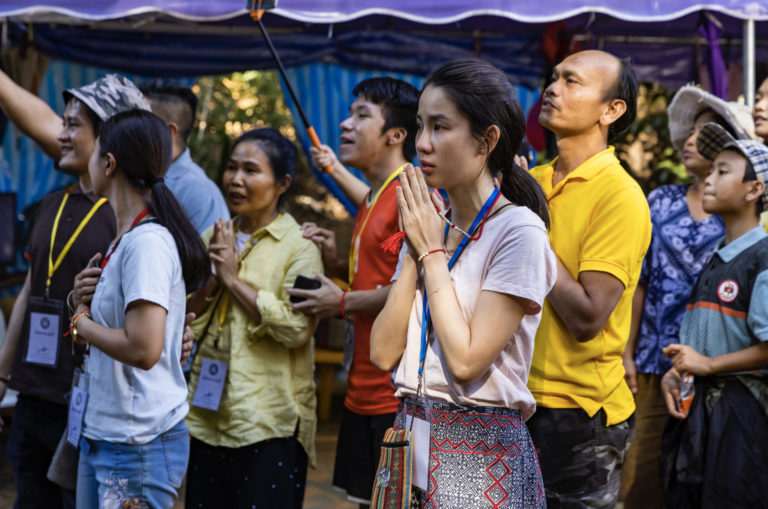
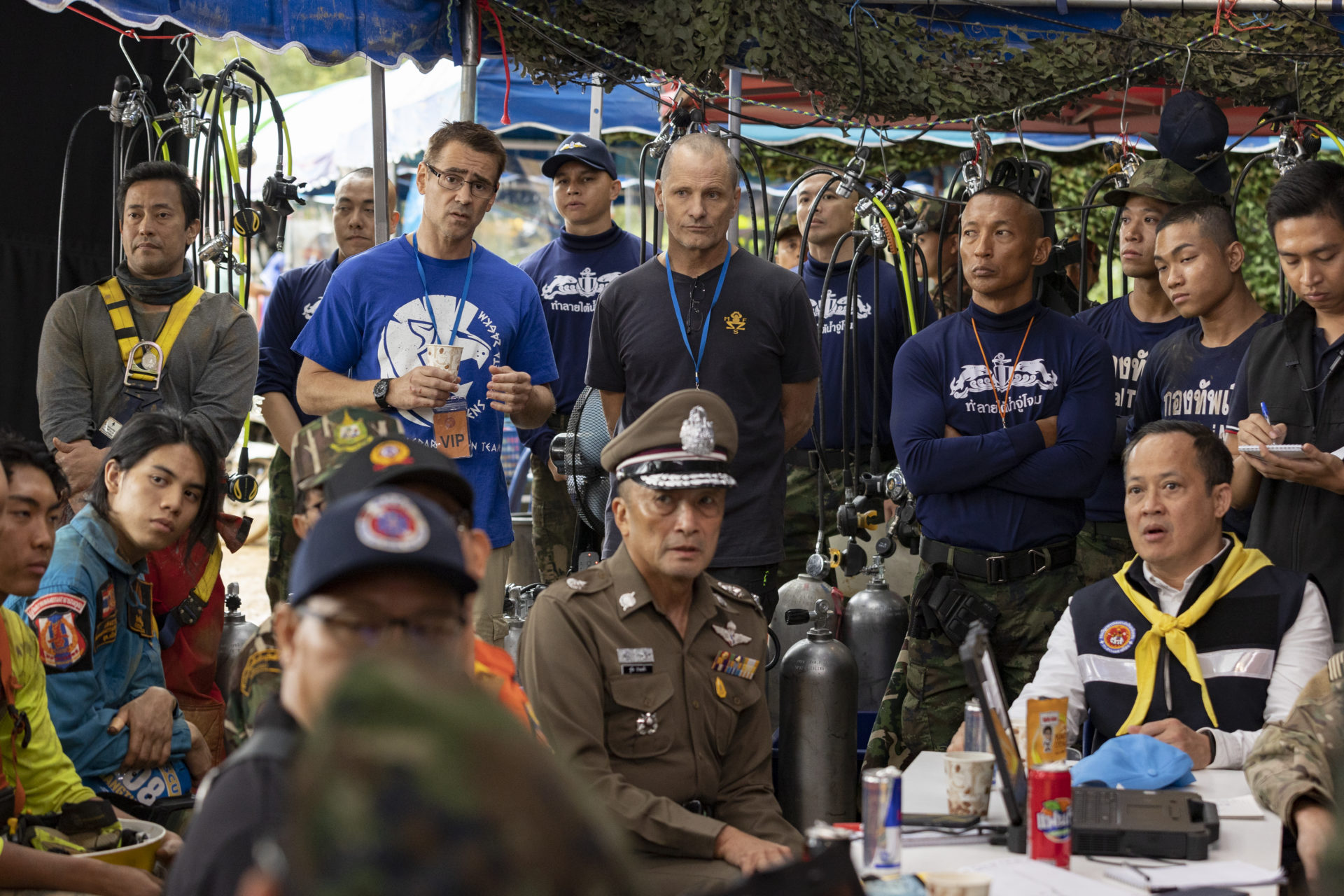
Credit: Vince Valitutti / Metro Goldwyn Mayer Pictures
© 2022 Metro-Goldwyn-Mayer Pictures Inc. All Rights Reserved.
Exclusive Interview with actors James Teeradon Supapunpinyo (Coach) , ‘Poo’ Sahajak Boonthankit (Governor Narongsak), Weir Sukollawat Kanaros Wirot Nilphongamphai, Navy Seal) , ’Ploy’ Pattrakorn Tungsupakul (Buahom, Mother) and Producer Raymond Phathanvirangoon.
Q: Obviously, you couldn’t go to the actual cave because it’s such a dangerous place. So the cave was recreated. What was the process with the production designers and with divers Rick Stanton and Jason Mallinson as technical advisors?
RP: It’s really thanks to Molly Hughes, the production designer, aided by a Thai art director who has worked on very big films as well such as “Troy” with Brad Pitt, and others.
Molly was so exact. What she did with the caves was absolutely amazing. Obviously, we can’t shoot in the actual caves because it’s way too dangerous. So we had multiple tanks dotted around to create the cave sections, and the caves themselves were very, very mechanical and technical because we had to be able to lower the water, to make it go up, create waves and turbulence. It was actually quite technical, and I was really impressed when I saw it.
But I also was terrified, because I saw some of the holes that they had to fit through. And these are recreations. I was like, “How do you fit into a hole this [size] as a person?” I was like “Omigosh, this is terrifying!” And really, it was exact.
We had Rick Stanton and Jason Mallinson, two of the original heroes who were the divers. They were there during the shoot, especially Rick who was there the whole time to make sure that things were accurate. They weren’t just consulting on the side, they were also getting into the water and literally training our actors, which is the reason why the actors dared themselves to perform basically all the stunts themselves. I think that that’s all really incredible.
Of course there’s also the exterior of the caves where you see, for example, when the kids go inside. There are these labyrinthian passageways and things like that. They actually had to fit into those caves as well. Some of them you see when they’re dry, but later on they’re actually flooded with water.
Imagine, those caves we recreated had to be so technical because they have to really go up and down and look authentic whether [they’re] dry or wet. So hats off to the whole production design and to the technical team for getting all of that right. Of course, it would have been great to shoot in the actual location, but for safety and everything, it was really not possible.
Of course, there was another problem, which was the pandemic. We were shooting in February, 2021, and during that time Thailand had a stipulation where we could only shoot with 20 people on set at one time. But [given] the scale of the film — that wasn’t possible. Yet, we were very lucky because at that time Australia had no cases so we shot there. Later on, unfortunately, Australia did have some very severe cases of Covid afterwards, but we had wrapped by then.
But it was a shame, because we actually had planned to shoot in Thailand for two months afterwards, and suddenly we had to re-jig the whole thing because of the pandemic situation. We did shoot in Thailand in the end, obviously, but not as much as we had hoped for.
Weir: We were on set for scenes but there were many, many chambers in the set. They had a professional diving team for shooting when they helped us get the shot. But the cave was very narrow and dark. It was quite scary.
Q: What was the casting process? Did you guys audition or did Ron Howard just contact you?
James: The casting team at Living Films called me and said, “Ron wants to see you on Zoom.” Then we had another casting on Zoom with Ron. The first time, I thought this role wasn’t meant for me. I didn’t know why. My personality is very different from the Coach, but as an actor you have to be able to change [to fit the character]. But on the first impression I made with Ron, I had long, brown hair. “Is that real? You actually want me to be the coach?” So afterwards, I go home and I think, “The role’s not going to fit me. They’re not going to call me.” But after two days they called me: “Okay, James, we choose you and you have to play him to the end of the story.” “What?! Is that real?”
Ploy: I went to audition three times. We auditioned through Zoom. The first time I met Ron [Howard] on Zoom, he gave me a script and let me [read]. He let me [read] on many levels of emotion. He interviewed me, asking, “Do you have a boyfriend? Do you have a husband? Do you have kids?” My answer was, “Ron, I’m so sorry. I have nothing that you’ve ask for. I’m single.” He said “Okay, let’s play,” and gave me a script. I read for him three times and got this role.
Q: Ploy, Did you get a chance to talk to any of the mothers of those kids? What kind of preparation did you do to play the mother of one of the boys stuck in the cave?
Ploy: At that time, during the [period] of Covid, it was hard for me to meet the real parents. But [through] hard work, I did research a lot. I watched videos. It was around a few hundred videos. I watched the news, the real interviews and [I watched] the documentary of the real parents just to focus, especially on the reactions of the parents at that time. I called my Mom and talked to my friend who had just given birth: “How [would] you feel? What if it happened to you?”
I asked myself, what if it happened to me? That’s how I did it, because I’m not a mom yet. I did everything I could in that time to get into this role. For me, it was such pressure [because] Ron trusted me [with] this role.
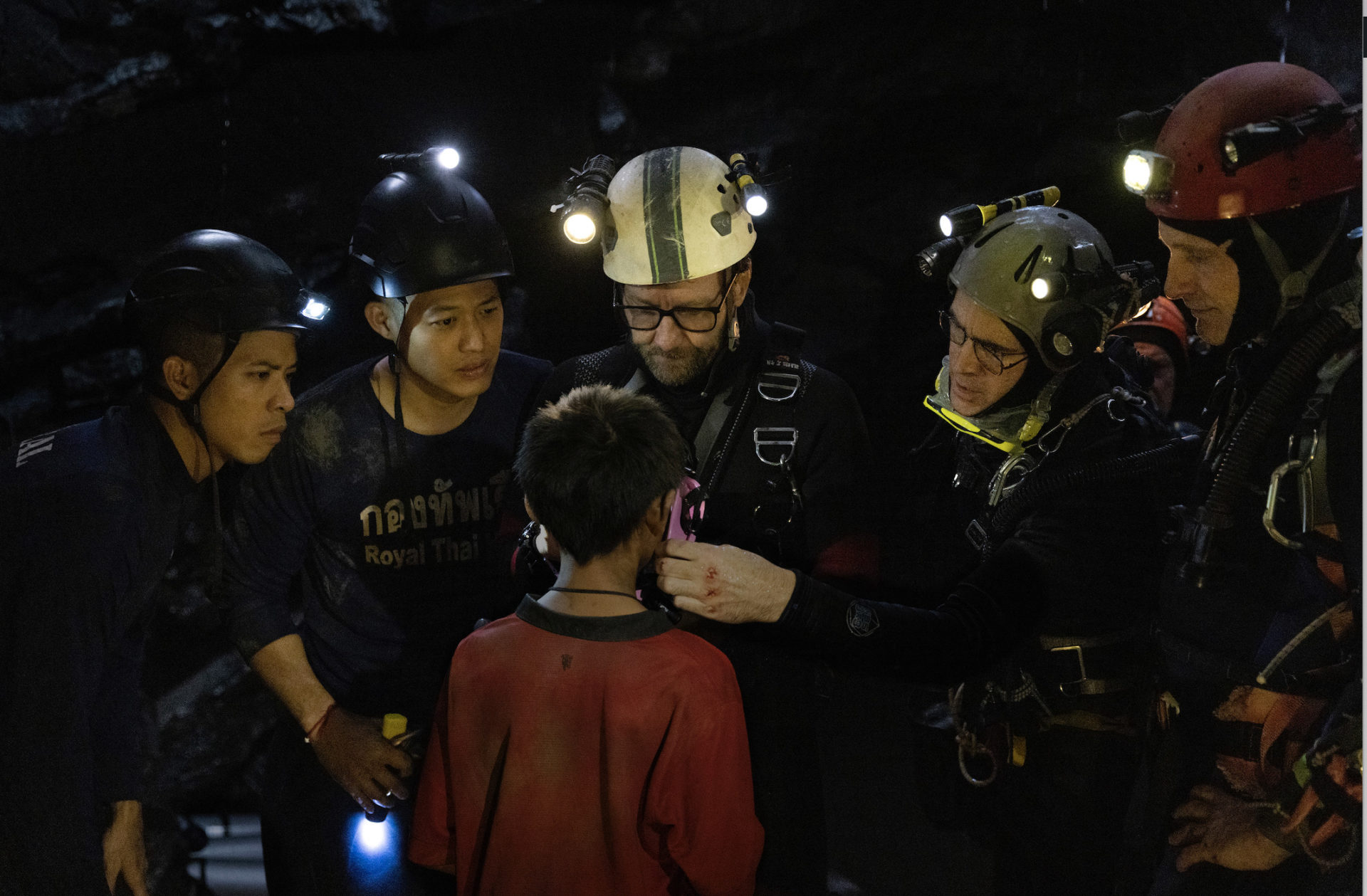
Q: One of the fascinating things about the Coach was that he suggested to the kids that they meditate while they were in the cave. Usually people are in a panic or moving around, and a lot of energy would have gotten lost during the 10 days they were trapped there. In your research, what was the surprise element about the Coach and Governor Narongsak during the rescue?
James: Wow, four years ago — I remember that. I heard in the news that the boys were stuck in a cave and they still couldn’t find them. After the sixth, seventh or eighth day, I though, with no food or water inside a cave — they’re not going to survive, for sure. But when the news came out that they were still in the cave for 10 days and they all survived, I’m like, “What?! How could they have done that?” A miracle had happened for kids and with all the help and people from around, they would make this thing happen.
So when I got this role, I had to do a lot of research about meditation — what is real meditation? If you do meditation, what is going to happen to your body? I found out that in meditation the Buddhist way, we have many, many levels. The Coach had been a monk for eight years.
When you meditate a lot, it calms you so much that your body goes into a kind of hibernation. When you’re in a hibernating state, it’s like being a bear, so you can save a lot of energy. That’s the only thing that Coach could do.
I think the Coach felt guilty all the time they were in the cave. He was supposed to take care of the boys and was supposed to get them out of the cave. But he couldn’t. They were stuck there with no food or water. He didn’t know if someone was going to help or not, when it was going to stop raining or when it was going to stop flooding. So he felt guilty all the time. But the only thing that he could do was [keep] the boys alive as long as possible. He hoped that one day they were going to have a miracle — and the miracle happened.
Poo: What did I get from this? It showed me that one man can do a lot. In this case, they were all Sakiru; tens of thousands of people came from all over the world to help, especially the Thai people. So this gamut of people all came to this one province — where the troubles were going on, the rain was coming in and everything was happening — and this one man had to manage all this.
I found out that he’s academically very clever. He even studied astrology or something like that. This guy studied everything. I found out that he is actually a very decent man as far as being a politician goes. He wanted to be rid of gambling and everything in the district where he was. He stayed and helped the children when he was going to be moved. There’s so much about this man, so this is what I’ve taken from it. It’s given me an uplift, a renewal of faith in the human mind and body. If you really want to do it, you can.
Q: In any Ron Howard production, he really gets into every detail. What was it like to collaborate with him? How much detail did you get to guide you through the whole process while shooting?
James: Ron cares about every little detail, even the smallest. He cared, and wanted everything to be authentic. He kept asking us: “Is that real for Thai people? Does that make Thai people say that? He cared about every detail about the culture, everything. Ron has a very open mind.
In the movie I bring my own Buddhism amulet. It’s a real one that the Coach is wearing when he’s stuck in the cave. I showed it to the team and talked with Ron, and they allowed me to wear that throughout the whole movie. If you watch it, you’ll never see it. But down to the smallest detail Ron cares so I wore it. I loved working with him and can say that everything that came out in this movie is authentic.
Q: You mentioned in the re-creation of the cave the feeling of still being so confined while getting to the cave area. For actors like Viggo Mortensen and Colin Farrell, they weren’t using doubles. They were doing their own stunts and everything. What kind of safety measures were in place for this production? Even a re-creation can be [hazardous] to go into.
RP: Of course we had a lot of precautions. The water, like I said, could be lowered to basically make it go up or down. Of course, not only were Rick and Jason there, but we had a lot of other people supporting us. There were always people watching, and we could always see them when they were underneath, so basically they are never fully covered. And if we needed to, we could go inside.
Of course, it’s still not easy. In fact, one of our stunt divers actually cut out. He had a bit of a panic during one of the tests. But they were never really in danger, and that’s really key. Plus, they did so much training with Rick. In fact, Viggo went to some caves in Spain before the shoot, at the recommendation of Rick Stanton, to meet some of the experts there. He even went spelunking by himself a bit.
We didn’t actually ask the actors to do their stunts themselves. They were the ones who wanted to. In fact, Ron was saying that it wasn’t even ideal for them to do so because our schedule was so tight. But if they wanted to, they’d have to make the tanks available, and all these things. The actors were like, “No no no, we will do everything. Don’t [pay] us for overtime, anything [like that]. We are going to train every weekend. This is on us. We’re going to do it. Don’t even worry about it.” And we’re like, “Okay.” It was really them that pushed to make sure that they were the ones going inside.
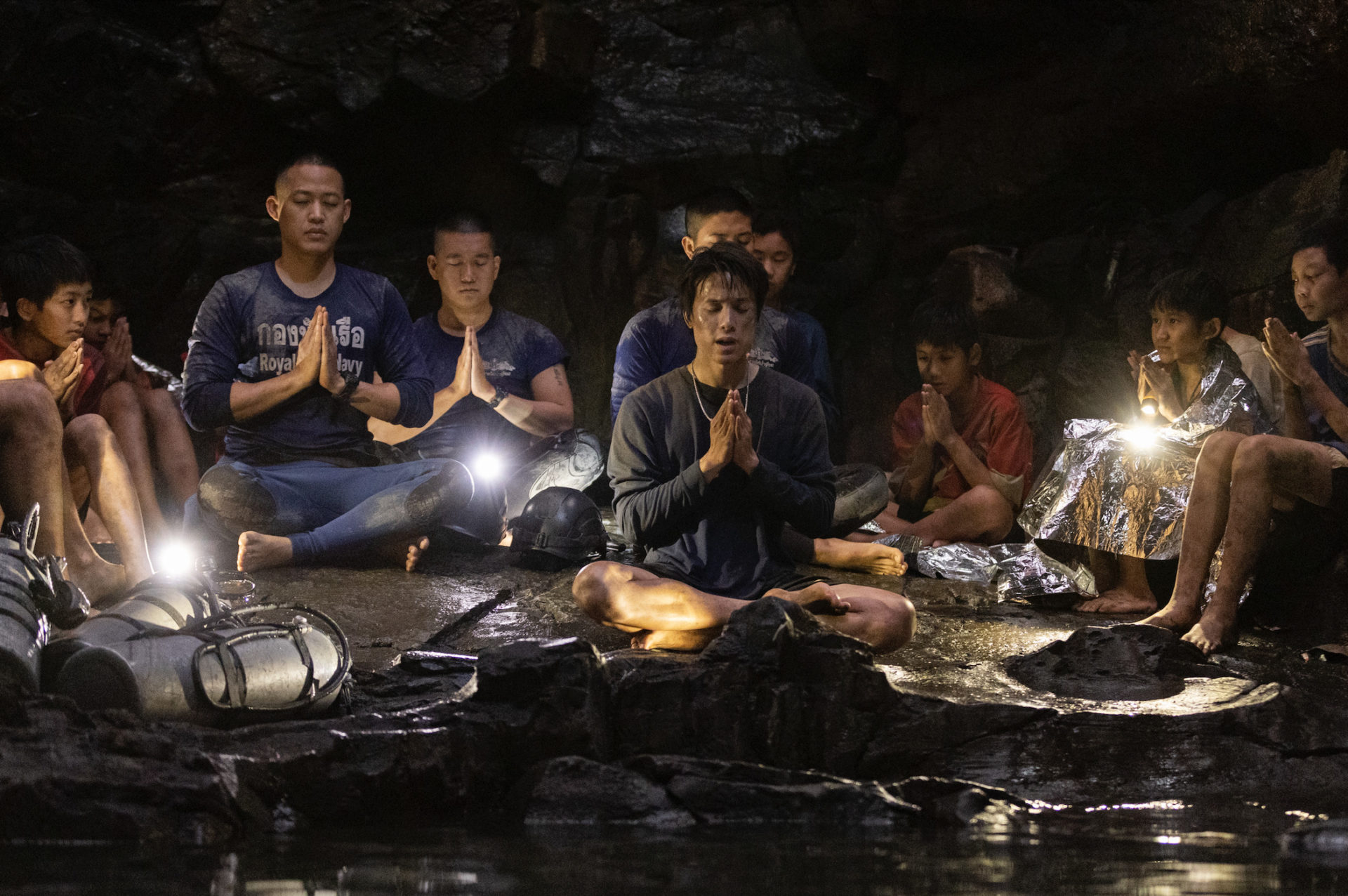
Q: As a producer, you wanted to make it as accurate as possible. Did you set up the actors to meet with the real people and learn what it was like to go through the experience?
RP: I came on board slightly later, maybe in June 2020. At that point, I think Ron already had the script for several months and had started talking to some of the experts. Obviously, without consulting with the experts, there was no way to make this film properly. He had already talked to Rick Stanton and Thanet Natisri, the water engineer guy, so that he could hear what it was like for them to get in there.
One of the first things that Ron and Imagine did was to set up so that they would actually be on set the whole time we were shooting, and they set up the meetings once we decided who the actors were. Ron had a very clear idea of both Viggo and Colin from the beginning because he felt they would match Rick and Jason when he met them. Once they were on board, the first thing they did was set up meetings for them.
It was basically part of the research that we already did to make the film as accurate as possible. It was not a difficult thing to reach out to them.
Q: What conversation did you have with Ron prior to shooting this film? What was the preparation to shoot in Thailand?
RP: It’s Covid times, right? So it didn’t really make a lot of difference whether I was in Bangkok or Los Angeles — it’s on Zoom. It’s just the way the world was. In fact, it’s so funny because I didn’t meet Ron in person until when I went there on the set. But we talked together for over a year so it was like we knew each other for a long time. That whole process was so organic.
I got on board because I’m a film producer and usually do independent cinema. So I’d done films that had been in major festivals like Berlin, Cannes, Venice, and others. One of the people who worked at Imagine as a producer — her name is Janice Tua — was the one who reached out to me and said, “Hey, we have this project that involves Thais. Can you come in to talk? Maybe we have you as a consultant.”
I was not a co-producer on the film at the time. I didn’t know what the project was. I didn’t know it was Ron Howard. I just went in and then went, “Oh! Okay.” He wanted me to read the script, and, from my perspective, get a sense of its accuracy, and he also wanted to know a lot of the nuances that he had to portray. He wanted to make sure that the Thai elements were accurate because there’s no point in portraying the story incorrectly when there are millions of hours that were recorded about this event in 2018. So that’s how I started coming in.
What I really liked about it was that Ron said to me, “Look, the world is in a rough place right now because we’re going through a pandemic. And of course socially and politically there is a lot of upheaval everywhere. This event in 2018 was something that shows that when we come together in a spirit of volunteerism, miracles can actually happen and we can perform something so much greater than ourselves.”
It’s not about selfishness. It’s not about being defined by your race or nationality, or your preferences, or whatever. It’s just about people coming together and making something really extraordinary happen like the rescuing of the 13 kids. It’s the kind of message that Ron said to me that he wanted to show in this day and age because we really need it. There is so much cynicism. Isn’t it nice to be reminded that when we do come together, we can do something great?
I was immediately sold. I was like, “Wow, this is such an amazing message that we want to get out, especially in today’s world.” So that’s how I got involved.
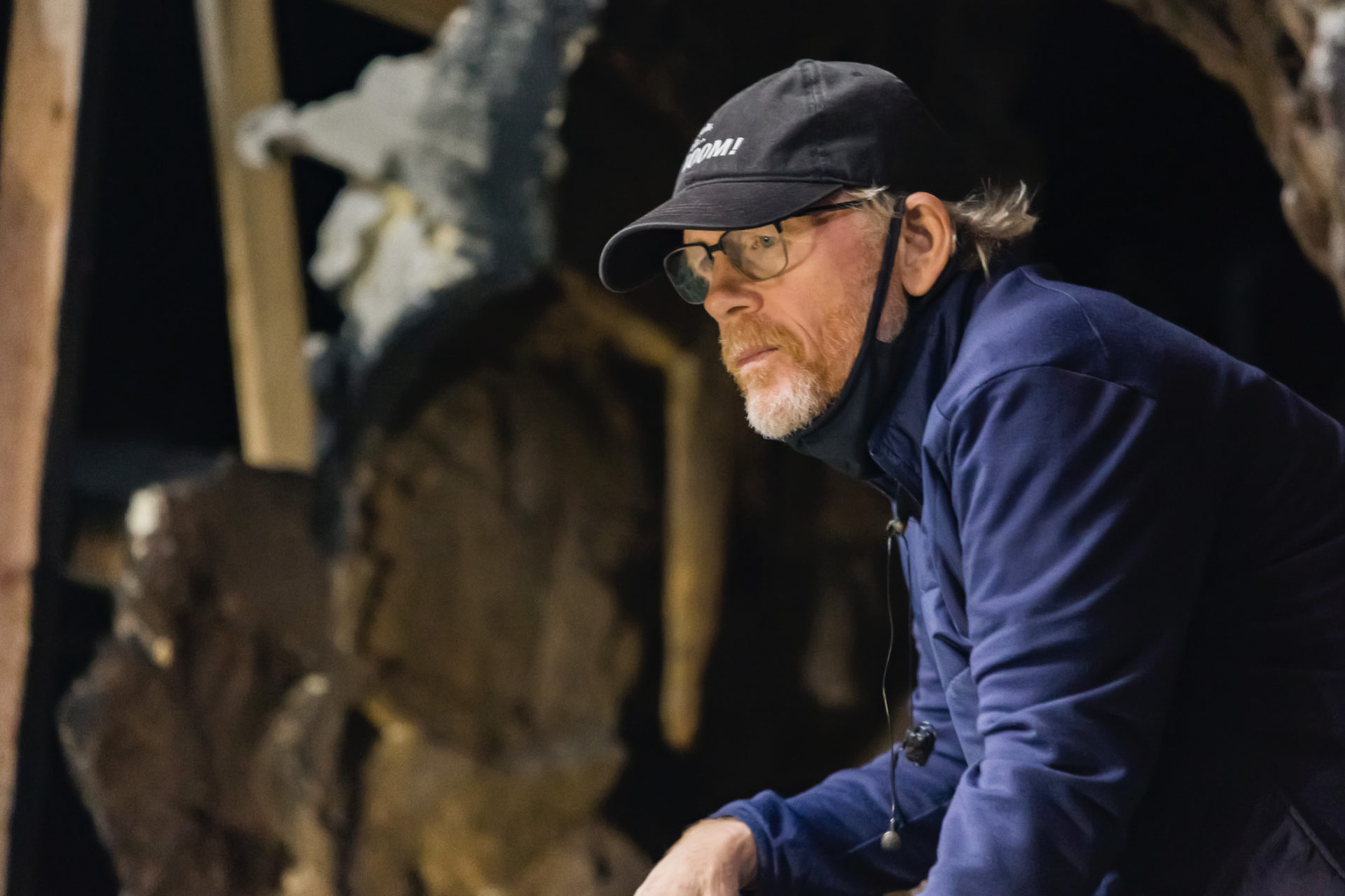
Q: The film really takes us inside the cave and shows us the efforts of those divers. Particularly when it came to the cinematography capturing those elements, what kind of preparation did you have to do to capture not only inside the cave, but also underwater?
RP: Our DP [director of photography], Sayombhu Mukdeeprom, who’s also Thai, really worked extremely hard to get it right. Shooting underwater is not easy. It’s dark and murky. It’s not the most exciting thing you see normally. But as to the nature of what we can see clearly, we also had to get out the oppressiveness and darkness inside, while seeing all the actions that are happening — that was really crucial.
More importantly — and this is something that rarely ever happens — we actually stuck the cameras on the actors themselves, and even had them sometimes navigate the cameras themselves because they could get that kind of intimacy of the shots that we wouldn’t be able to if it was wider. In some ways, some of the shots that were captured by the actors, like Viggo and Colin, actually made it into the film because they were so dynamic and electric. You see them from a really, really up-close point of view.
We also had a really great second unit director, Charlie [Charles Croughwell], who’s extremely talented in shooting stunts, so he worked really hard with the stunt divers and the other DPs to make sure that all the action was clearly seen.
Q: This film will be released on Amazon Prime and seen by people all over the world. This will be the first time people can see what actually happened inside the cave. Knowing that, what was your experience shooting this film?
Poo: I want to say that it gave us a chance to have Thailand represented to the world. Ron and Amazon have now given us a chance to show Thailand to the rest of the world. I don’t think you saw any pad thai or any Thai boxing in there. So now you will see Thai culture and the Thai people. You see how we accept foreigners when they come. You will see how foreigners are when they’re in Thailand. You see that families, when they are in a stressful situation, help each other. It’s such a good time for this movie to come out, with all this mumbo jumbo that’s going on in the world today. And it happens to be about Thailand. So I am so stoked.
RP: I hope that what Ron said [will be understood]. I hope that people will watch it and really understand what we’re really trying to say, which is that this film is such a great way to show how selflessness and volunteerism can actually create something absolutely miraculous and wonderful, and remind us that we can do something greater than ourselves. I hope that people will come away with that kind of feeling and of positivity because we really need it right now.
Check out more of Nobuhiro’s articles.
Here’s the trailer of the film.

